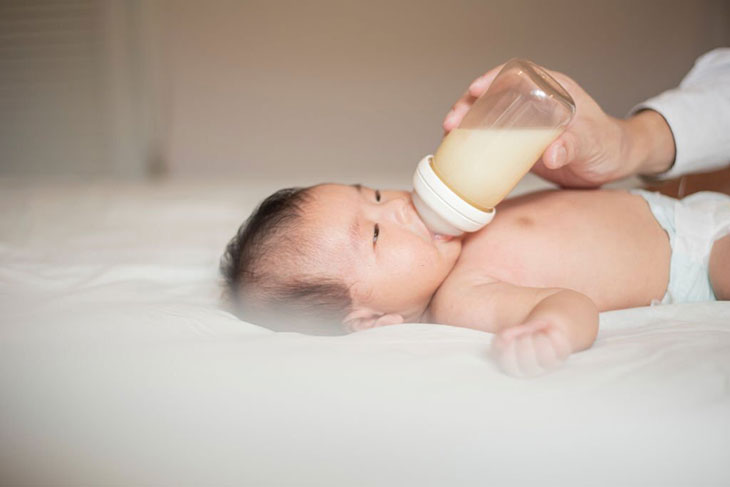Millions of parents face the problem “How often 2 month old eat” daily, especially those having a child for the first time. That’s why we wrote this blog.
We will show you how to cope with growth spurts and hunger signals, helping you avoid the mistakes that can harm your baby’s health and development.
Don’t miss this opportunity to learn how to feed your 2-month-old baby correctly!
How Often 2 Month Old Eat? Useful Answer!

There is no right answer to “How many feedings for 2 month old” which is extremely challenging for you.
Your baby’s appetite and nutritional needs may vary depending on their weight, growth, and development.
A 2-month-old baby usually eats 4 to 5 ounces of breast milk or formula every three to four hours.
Some babies may eat more or less frequently, depending on their hunger cues and preferences.
If you are following formula feeding, you might want to look for one supplemented with 2’-FL HMO, a prebiotic that supports your baby’s immune system.
You should burp your baby after each feeding and offer a pacifier if they still seem fussy.
Remember that feeding your 2-month-old baby can be a wonderful way to bond with them and help them grow healthy and strong.
How Do You Know That Your 2-Month-Old Baby Is Hungry?
Before determining “How much do babies eat?”, you should know when your baby on demand is to eat or drink.
The 24-hour period has many different stages in which your child can feel hungry; thus, you must catch common signals to provide them with a timely solid food or milk supply.
Below are some useful suggestions for you:
Crying
Babies cry to let you know they need something, such as food, comfort, or a diaper change.
When your baby is hungry, they may cry mildly at first and then more intensely as their hunger increases.
Therefore, you must feed your child as soon as possible to help them stay calm and eat more easily.
Please prepare healthy foods for your child, which allows you to modify to have a responsive feeding balance.
Common Other Signals
Your baby doesn’t cry for anything. Crying is their late sign when hungry; thus, you don’t wait until they call to feed them. Watch for the early symptoms, such as:
- Sucking fingers or hands
- Wetting lips
- Opening and shutting mouth
- Nuzzling mother’s breast, chest, or bottle
- Making little noises or movements with the mouth
- Wriggling or fussing when seeing food
How To Properly Feed 2-Month-Old Babies?

Whether breastfeeding or formula-feeding, you must know which right source of nutrition or any variety of foods matches your baby’s demand this month.
Your child’s growth rate will depend on the 2 month old feeding schedule a lot, which can balance your child’s health at the first stage of their life.
You should consult an experienced doctor to adopt a good and typical feeding schedule for your child.
We will give you some useful advice for milk alternatives in your child’s diet in 2-4 months; let’s note them now.
Which Food Can A Baby Eat This Month?
Your 2-month-old baby needs nothing but milk. Milk has everything your baby needs to grow strong and healthy for the first half year.
You must feed your baby when they want it, day or night.
If you apply to breastfeed, the proper time is every 2 to 3 hours. Once you raise your formula-fed babies, you should do it every 3 to 4 hours.
Your baby may drink about a quarter of their weight in formula every day.
Remember not to give your baby anything else to drink or eat until they are 6 months old. Other drinks and foods can upset your baby’s stomach and spoil their appetite.
Wait until your baby shows you they are ready for other foods, like sitting up, looking at food, and opening their mouth for a spoon.
Signs To Tell If Babies Are Getting Enough To Eat?
You normally catch signs that your babies are getting enough to eat through daily diapers and growth charts.
However, some newborn babies do not express these symptoms, depending on their health conditions or behaviors in the first months of life.
You can consult what daily diapers or growth charts are suggested below.
- Daily diapers: Your baby’s diaper is a clue to their feeding. Your baby should wet 2 or 3 diapers daily for the first few days. Then they should soak at least 5 or 6 diapers a day. How often they poop varies on whether they drink breast milk or formula.
- Growth charts: Your baby’s doctor will weigh your baby and show you how they grow on a graph. The chart tells you if your baby is getting enough food. If your baby grows well, they are eating well. This solution is a good option for parents having their babies for the first time.
Which Are Common Problems Of A 2 Month Old Baby Feeding?
There are many feeding patterns when considering milk per feeding for two-month-old babies.
If you give frequent feedings constantly, the pound of body weight of your babies can be seriously impacted.
To help you restrict common mistakes while feeding a 2-month-old baby, we will show the main reasons for these problems. In particular:
Too Full For A Baby
Too much food can hurt your baby’s stomach, making them fat later. It’s better to give less and see if your baby wants more. This also lets your baby feel when they are full.
If your baby always wants to eat, even when they are not hungry, talk to your baby’s doctor.
You can give healthy-weight babies a pacifier after feeding if they like to suck for fun, not food.
For breastfed babies, wait until they are good at breastfeeding, around 3 to 4 weeks old.
Gaining Weight On A Baby
Your baby will grow fast. They will be twice as heavy at 5 months and three times as heavy at 1 year.
If your baby is not growing well, feed them more often―even if you must wake them up.
You can ask your baby’s doctor how much and how often to provide your baby to improve this situation.
Are There Other Ways To Support A 2-Month-Old Baby’s Development?

Your baby’s brain grows greatly when you play and talk with them. If you want to know what your 2-month-old can do or how to have fun with them, try these activities:
- Read Good Things To Your Baby: Your baby hears and learns from your voice. They know how you say words and how you sound. Read the same book again and again―babies like that.
- Have Tummy Time: You should let your baby lie on their tummy daily to strengthen their neck, arm, and shoulder muscles. Put them on their tummy on a hard floor, and stay close and watch.
- Get Your Baby Close To The Sound: Expose your baby to various sounds stimulating their curiosity and imagination. Musical toys and instruments are ideal. But don’t neglect the noises of daily life. It would help if you let them hear you vacuuming, washing dishes, or mowing the lawn. Keep them close and safe, of course.
- Talk To Your Baby: Chat with your baby when they make sounds and share what you do with them. Listen carefully and don’t interrupt or look away when they “talk.” This shows them you value their voice and helps them trust you more.
FAQs
How Is A 2 Month Old Baby’s Feeding Schedule?
It is a schedule covering predictable patterns, the number of ounces per formula feeding, and the feeding time frame (3-4 hours or 4-5 hours).
You should follow specific guidelines from Nutrition Health Associates Inc to ensure a healthy diet for your child.
How Do You Count Time Space Between Each Feeding For Your Baby?
There is a good answer to the issue “How long between feedings for 2 month old“.
It would be best if you depend on your child’s condition, including health, growth rate, hunger frequency, and other external factors.
Remember that keeping your breast milk supply healthy is more important than counting the time space between each feeding for your baby.
Conclusion
The rate of growth for your baby remarkably depends on how often 2 month old eat because the first timeframe plays an important role in building an adaptive feeding for your child in the long term.
You should follow the suggested ounces per feeding and monitor the proper time between feedings to ensure your child’s health best.
